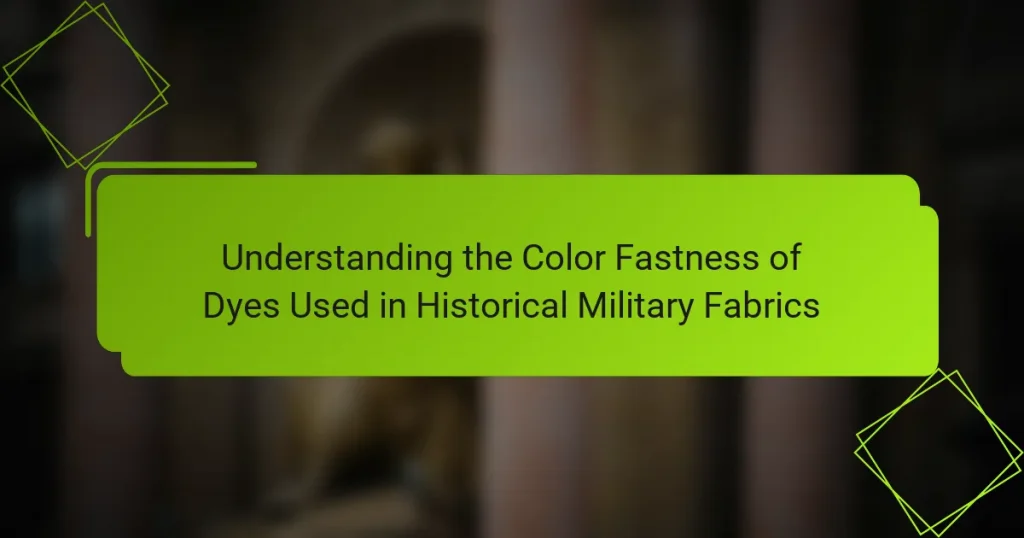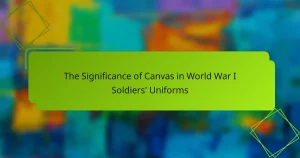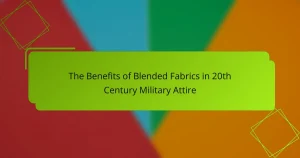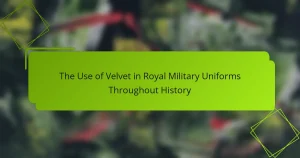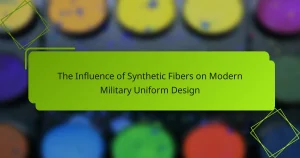Color fastness refers to the resistance of dyes used in historical military fabrics to fading or running under various conditions, which is essential for preserving the appearance and integrity of military uniforms. This article examines the impact of natural dyes, such as indigo, on color fastness, highlighting the factors that influence dye durability, including the dyeing process and fabric type. Standardized testing methods, including light, washing, and rubbing tests, are employed to assess color fastness, guided by specific standards like ISO 105. The significance of color fastness in the restoration of military textiles is emphasized, as it affects the longevity and authenticity of restored artifacts. Understanding these principles is crucial for conservators working to maintain the historical integrity of military fabrics.
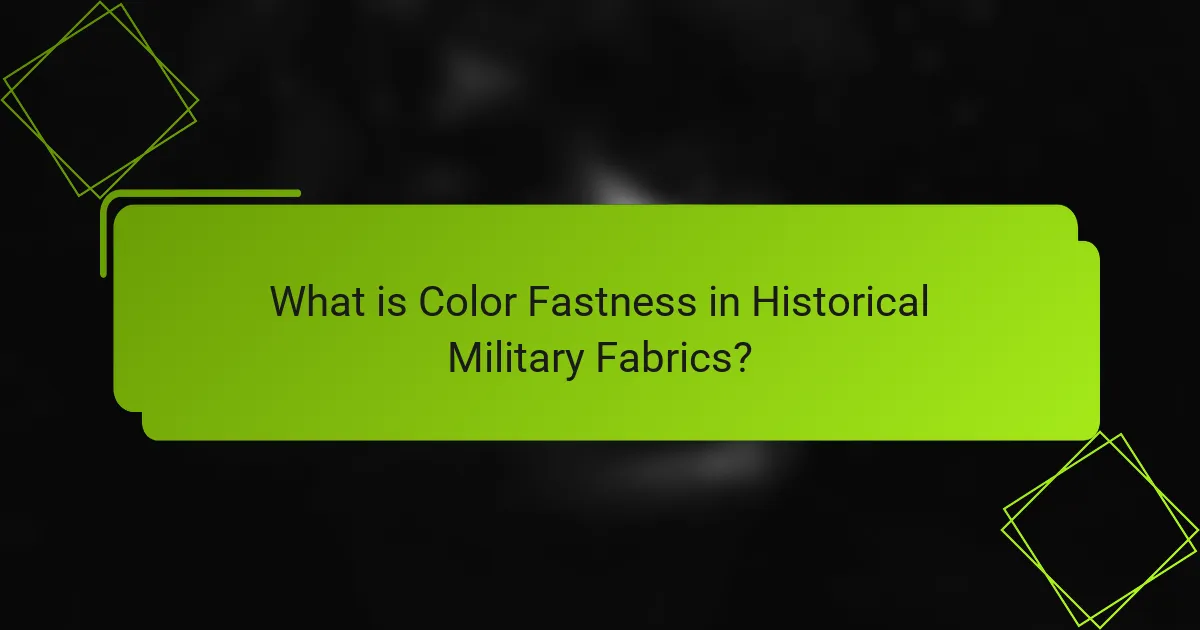
What is Color Fastness in Historical Military Fabrics?
Color fastness in historical military fabrics refers to the resistance of dyes to fading or running when exposed to various conditions. This characteristic is crucial for maintaining the appearance and integrity of military uniforms over time. Historical military fabrics often used natural dyes, which had varying levels of color fastness. For example, indigo was commonly used, but it could fade significantly with exposure to sunlight and washing. The durability of these dyes was influenced by factors such as the dyeing process and the fabric type. Historical records indicate that some military uniforms required frequent replacement due to color degradation. Understanding color fastness helps in the preservation and restoration of military textiles today.
How is color fastness defined in the context of dyes used in military fabrics?
Color fastness in the context of dyes used in military fabrics refers to the resistance of the dye to fading or running when exposed to various conditions. This includes exposure to light, washing, and environmental elements. Military fabrics require high color fastness to maintain uniformity and effectiveness in camouflage. Historical military applications often relied on natural dyes, which varied in color fastness. For example, indigo and madder were commonly used, but their fastness could degrade under certain conditions. Testing methods, such as the AATCC (American Association of Textile Chemists and Colorists) standards, measure color fastness. These standards provide a systematic approach to evaluate how well a dye holds its color in practical scenarios. High color fastness is crucial for operational durability and visual effectiveness in military textiles.
What are the key attributes that determine color fastness?
The key attributes that determine color fastness include dye type, fabric composition, and environmental exposure. Dye type affects how well the color adheres to the fabric. Natural dyes often have lower fastness compared to synthetic dyes. Fabric composition impacts color retention; for instance, cotton generally holds color better than silk. Environmental exposure, including light, water, and heat, can degrade color quality. Light exposure can lead to fading, while water exposure can cause bleeding. Heat can also alter dye stability. These attributes collectively influence the overall durability of color in fabrics.
Why is color fastness important for historical military garments?
Color fastness is crucial for historical military garments to maintain their appearance and authenticity. It prevents fading and discoloration from exposure to light, moisture, and washing. Historical military uniforms often represent specific time periods and regiments. Preserving their original colors helps in accurate representation and study of military history. Faded colors can mislead historians and collectors regarding the garment’s age and significance. Additionally, color fastness ensures that the garments remain visually appealing for display and educational purposes. For instance, uniforms from the American Civil War are often analyzed for their dye stability, which reflects the textile technology of that era.
What types of dyes were commonly used in historical military fabrics?
Historical military fabrics commonly used natural dyes. These dyes included indigo, madder, and cochineal. Indigo provided a deep blue color and was widely used. Madder produced red hues and was essential for various military uniforms. Cochineal, derived from insects, offered vibrant reds. Additionally, oak and walnut were used for browns and blacks. These natural dyes were favored for their availability and effectiveness. Historical records confirm their usage in various military applications.
What natural dyes were prevalent in military textiles?
Natural dyes prevalent in military textiles included indigo, madder, and cochineal. Indigo was commonly used for its deep blue color. It was derived from the indigo plant and provided excellent colorfastness. Madder produced shades of red and was extracted from the madder root. Cochineal, sourced from insects, offered vibrant red hues. These dyes were favored for their availability and durability. Historical records show their extensive use in uniforms from various armies. The use of these natural dyes significantly influenced the visual identity of military forces.
How did synthetic dyes change the landscape of military fabric coloration?
Synthetic dyes revolutionized military fabric coloration by enabling a broader spectrum of colors. Prior to their introduction, natural dyes were limited in color range and often faded quickly. Synthetic dyes provided vibrant, durable colors that resisted fading and washing. This durability was crucial for military uniforms exposed to harsh conditions. The introduction of synthetic dyes allowed for standardized colors across different military branches. This standardization improved uniformity and identification among troops. Additionally, synthetic dyes facilitated the production of camouflage patterns, enhancing concealment in various environments. Overall, synthetic dyes significantly advanced the functionality and aesthetics of military fabrics.
What factors influence the color fastness of dyes in military fabrics?
The color fastness of dyes in military fabrics is influenced by several factors. These factors include the type of dye used, the fabric composition, and the dyeing process. Synthetic dyes generally offer better color fastness compared to natural dyes. The fiber content of the fabric also plays a crucial role; for example, polyester tends to retain color better than cotton. Additionally, the presence of mordants during dyeing can enhance color retention. Environmental conditions, such as exposure to sunlight and moisture, further affect color stability. Testing methods, like washing and rubbing tests, help determine the level of color fastness. Research indicates that military fabrics have evolved to improve durability and color retention over time.
How do environmental conditions affect dye longevity?
Environmental conditions significantly affect dye longevity. Factors such as temperature, humidity, and light exposure play crucial roles. High temperatures can accelerate dye degradation, while excessive humidity may promote mold growth, leading to fading. UV light exposure is particularly damaging, breaking down dye molecules and causing color loss. Studies have shown that dyes exposed to direct sunlight lose up to 50% of their intensity within a year. Conversely, controlled environments with stable temperatures and low light can extend dye life significantly.
What role does fabric composition play in color fastness?
Fabric composition significantly influences color fastness. Different fibers react differently to dyes. Natural fibers like cotton and wool tend to absorb dyes well, enhancing color retention. Synthetic fibers, such as polyester, often exhibit superior color fastness due to their chemical structure. The presence of certain additives in fabric can also affect dye adherence. For example, fabrics treated with specific finishes may resist fading better. Additionally, the dyeing process itself varies based on fabric type, impacting how colors hold up over time. Research shows that polyester blends can maintain color integrity longer than pure cotton in various washing conditions.
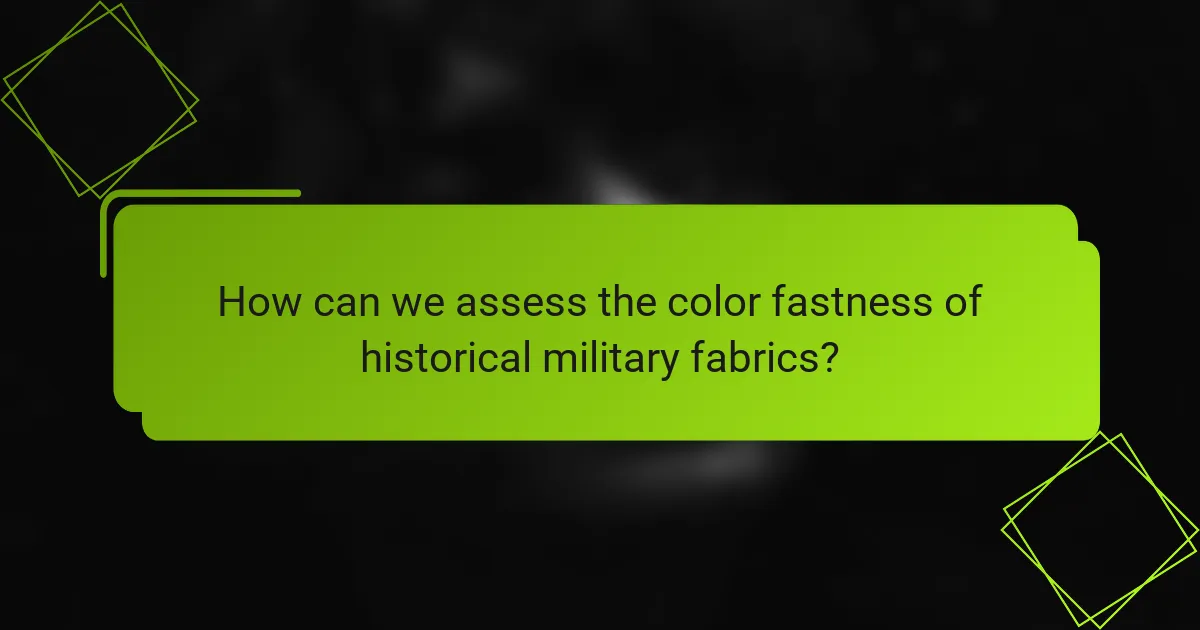
How can we assess the color fastness of historical military fabrics?
To assess the color fastness of historical military fabrics, standardized testing methods are employed. These methods include the use of light, washing, and rubbing tests. The light fastness test evaluates how well the fabric resists fading when exposed to sunlight. The washing test determines the fabric’s ability to maintain color after laundering. The rubbing test checks for color transfer when the fabric is subjected to friction.
Specific standards, such as ISO 105, guide these assessments. Historical military fabrics often contain natural dyes, which can vary in their color fastness. Research indicates that certain dyes, like indigo, are more prone to fading. Additionally, the age and storage conditions of the fabric can impact color stability. By applying these testing methods and standards, a comprehensive evaluation of color fastness can be achieved.
What testing methods are used to evaluate color fastness?
The main testing methods used to evaluate color fastness include the AATCC Test Method 61, ISO 105-C06, and the Crockmeter test. AATCC Test Method 61 assesses color change due to laundering and exposure to light. ISO 105-C06 evaluates color fastness to light under specific conditions. The Crockmeter test measures color transfer when fabrics rub against one another. These methods provide standardized procedures for determining the durability of dye on fabrics. Each method ensures consistent results that can be compared across different studies and applications.
What are the standard procedures for color fastness testing?
Standard procedures for color fastness testing involve several key methods. The most common tests include washing, light, and rubbing fastness evaluations.
For washing fastness, samples are subjected to a standardized washing process. This often involves using detergents and specific temperatures. The samples are then visually assessed for color change or staining.
Light fastness testing exposes samples to artificial light sources. This simulates sunlight exposure over time. The degree of color fading is measured against a standardized scale.
Rubbing fastness testing assesses color transfer when fabrics are rubbed together. This is done using a standardized abrasion method. The amount of color transfer is evaluated on a white cloth.
These procedures are essential for determining the durability of dyes in fabrics. They help ensure that historical military fabrics maintain their appearance over time.
How do these methods differ based on dye types?
Methods for dyeing fabrics differ significantly based on dye types. Natural dyes often require a mordant to fix the color, while synthetic dyes typically do not. The application process for natural dyes can be more complex and time-consuming. Synthetic dyes usually offer a broader color range and greater consistency.
Natural dyes may fade faster under light exposure compared to synthetic dyes. Additionally, the wash fastness of natural dyes can vary widely depending on the source material. Synthetic dyes generally provide superior wash fastness due to their chemical stability.
These differences impact the longevity and appearance of historical military fabrics. Understanding these distinctions helps in preserving and restoring historical textiles accurately.
Why is it essential to maintain color fastness in historical preservation?
Maintaining color fastness in historical preservation is essential to ensure the integrity of artifacts. Color fastness prevents fading or discoloration over time. This quality is critical for preserving the original appearance and significance of historical items. Faded colors can alter the interpretation of an artifact’s historical context. In military fabrics, color can signify rank, unit, or historical events. Studies show that light exposure and environmental factors can degrade dyes. For instance, the International Council of Museums highlights that preserving original colors aids in accurate historical representation. Therefore, maintaining color fastness is vital for the authenticity and educational value of preserved artifacts.
What techniques are employed to preserve color fastness in artifacts?
Techniques employed to preserve color fastness in artifacts include controlled storage conditions, use of UV filters, and regular monitoring. Controlled storage conditions involve maintaining stable temperature and humidity levels. This prevents fading and deterioration of dyes. UV filters are applied to windows or displayed cases to block harmful sunlight. Regular monitoring ensures that any changes in color can be detected early. Additionally, the use of archival-quality materials for storage helps prevent chemical reactions that may affect color. These methods are supported by research indicating that environmental factors significantly influence dye stability.
How does color fastness impact the authenticity of historical military displays?
Color fastness significantly impacts the authenticity of historical military displays. It determines how well the colors of fabrics resist fading over time. High color fastness indicates that the original colors remain vibrant, preserving the historical accuracy of the display. Conversely, low color fastness leads to color degradation, altering the appearance of military uniforms and insignia. This alteration can misrepresent historical facts and diminish the educational value of the display. Authenticity relies on accurate representation, which is compromised when colors fade. Historical research shows that many original military textiles were designed for durability, emphasizing the importance of color fastness in maintaining authenticity.
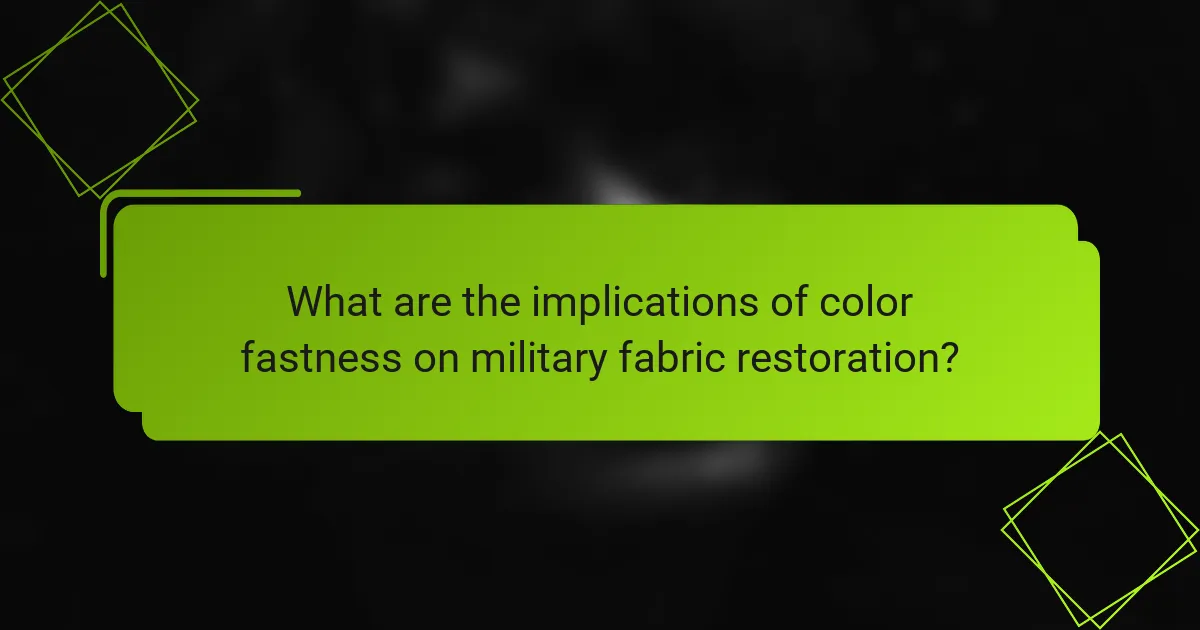
What are the implications of color fastness on military fabric restoration?
Color fastness significantly impacts military fabric restoration by determining the longevity and durability of the colors during the restoration process. If a fabric exhibits poor color fastness, the dyes may bleed or fade when exposed to cleaning agents or environmental conditions. This can compromise the authenticity and appearance of historical military textiles. For instance, fabrics restored with low color fastness dyes may not withstand light exposure, leading to uneven coloration. Conversely, materials with high color fastness retain their original hues, ensuring a more accurate restoration. Research indicates that color fastness ratings guide conservators in selecting appropriate restoration methods. This is crucial for preserving the historical integrity of military artifacts.
How can restorers ensure color fastness during the restoration process?
Restorers can ensure color fastness during the restoration process by conducting thorough testing of dyes and fabrics. This involves using methods such as lightfastness testing, wash fastness testing, and rubbing fastness testing. Lightfastness testing determines how well the dye withstands exposure to light. Wash fastness testing assesses the dye’s stability when subjected to washing. Rubbing fastness testing evaluates how the dye holds up against friction.
Restorers should also select dyes specifically formulated for historical textiles. These dyes often have better adhesion and stability. Additionally, the use of protective coatings can enhance color fastness. Proper storage conditions, avoiding direct sunlight and moisture, further contribute to maintaining color integrity.
Research indicates that historical military fabrics often require specialized care to preserve their colors. Studies show that using appropriate restoration techniques can significantly improve the longevity of colors in textiles.
What materials and techniques are recommended for maintaining color fastness?
Recommended materials for maintaining color fastness include high-quality dyes, mordants, and fixatives. Techniques involve pre-treating fabrics with mordants to enhance dye adherence. Washing fabrics in cold water reduces color bleeding. Using gentle detergents prevents fading. Sunlight exposure should be minimized to avoid UV damage. Storing fabrics in dark, cool places maintains vibrancy. Regularly rotating displayed items prevents prolonged exposure to light. These methods are supported by textile preservation standards that emphasize the importance of careful handling and storage.
How can restorers identify and replicate original dye formulations?
Restorers can identify and replicate original dye formulations through analytical techniques and historical research. They often use spectroscopy to analyze fabric samples. This method reveals the chemical composition of the dyes. Chromatography can separate different dye components for further study. Historical documents may provide insights into dye recipes used in specific periods. Comparing modern dyes with historical samples helps determine colorfastness and compatibility. Restorers may also conduct tests to replicate the dyeing process. By combining these methods, restorers ensure accuracy in recreating original colors.
What best practices should be followed for preserving color fastness in historical military fabrics?
To preserve color fastness in historical military fabrics, avoid exposure to direct sunlight. Sunlight can cause fading and degradation of dyes. Store fabrics in a cool, dark, and dry environment. Humidity can lead to mold growth, damaging both fabric and dye. Use acid-free tissue paper for wrapping and interleaving. This prevents abrasion and color transfer between layers. Clean fabrics gently with a soft brush or vacuum on a low setting. Harsh chemicals and detergents can strip dyes and weaken fibers. Monitor temperature and humidity levels regularly. Keeping these conditions stable ensures long-term preservation of colors.
What storage conditions are optimal for maintaining color fastness?
Optimal storage conditions for maintaining color fastness include cool temperatures, low humidity, and protection from light. Storing fabrics in a dark, dry environment minimizes exposure to factors that can cause fading. Ideal temperatures range between 60°F to 75°F (15°C to 24°C). Relative humidity should be kept below 50% to prevent mold and degradation. Additionally, using acid-free materials for storage helps avoid chemical reactions that can affect dye stability. Properly controlled conditions slow down the deterioration of color in historical military fabrics.
How can regular maintenance contribute to the longevity of color fastness?
Regular maintenance enhances the longevity of color fastness in fabrics. This involves proper washing techniques and avoiding harsh chemicals. Gentle detergents help preserve dye integrity. Regular cleaning prevents dirt buildup that can lead to fading. Additionally, air drying instead of machine drying reduces heat exposure, which can damage colors. Consistent care ensures that colors remain vibrant over time. Studies indicate that well-maintained fabrics show significantly less color degradation.
The main entity of this article is the color fastness of dyes used in historical military fabrics, which refers to the resistance of dyes to fading or running under various conditions. The article explores the significance of color fastness in maintaining the appearance and authenticity of military uniforms, detailing the types of dyes historically used, such as natural dyes like indigo and madder, and the impact of synthetic dyes on military fabric coloration. Key attributes influencing color fastness, including dye type, fabric composition, and environmental exposure, are examined, along with standardized testing methods for assessing color durability. The article also discusses best practices for preserving color fastness in historical textiles, emphasizing the importance of controlled storage and regular maintenance to ensure the longevity of military artifacts.
